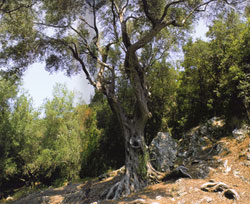|
|
|
Olive
Oil
 This evergreen
tree (Olea europaea) with its lance-shaped leaves
and their shimmering silvery-white undersides is an
oft-described emblem of Greece. The foliage is
replaced in a two-year cycle. In June, small, creamy
white flowers open on its branches. If successfully
pollinated by the wind in the last quarter of the
year, or even in January depending on the variety,
it ripens to produce blue-black fruits. This
undemanding tree thrives on poor, limy soils, can
survive with only 8 inches (200 millimeters) of rain
a year, and copes with temperatures ranging from as
low as 54 °F (12 °C) during the flowering season up
to 104 °F (40 °C) as the fruit ripens. It produces
its first crop after about eight years, being most
productive after between 60 and 100 years. It is
calculated that during this period, each tree
produces an average of 132 pounds (60 kilograms)
every year, with years of bountiful harvests
alternating with those of lower yields. Nowadays,
this natural cycle is controlled by specific pruning
of the branches to produce more even yields. The
best varieties of olives cultivated on Crete are
koroneiki (Olea europaea var. Mastoides),
throumbolia (Olea europaea var. Media oblonga), and
tsounati (Olea europaea var. Mamilaris). Koroneiki
is far and away more resistant than the common olive
tree, and thrives at altitudes of over 1500 feet
(500 meters). Its fruits are rather small, but all
the more aromatic for that. Throumbolia has been
cultivated for longer than the koroneiki on Crete,
but has now been replaced by the latter in many
regions. It grows at altitudes of up to 2100 feet
(700 meters), and its olives produce a mild oil,
well-balanced in terms of flavor. Tsounati can
withstand greater fluctuations in temperature, and
its fruits also guarantee production of a
high-quality oil. An olive tree can live for several
hundred years. With the passing of time, the wood
inside the trunk dies away, until finally the trunk
is hollow and takes on an oddly perforated
appearance. This evergreen
tree (Olea europaea) with its lance-shaped leaves
and their shimmering silvery-white undersides is an
oft-described emblem of Greece. The foliage is
replaced in a two-year cycle. In June, small, creamy
white flowers open on its branches. If successfully
pollinated by the wind in the last quarter of the
year, or even in January depending on the variety,
it ripens to produce blue-black fruits. This
undemanding tree thrives on poor, limy soils, can
survive with only 8 inches (200 millimeters) of rain
a year, and copes with temperatures ranging from as
low as 54 °F (12 °C) during the flowering season up
to 104 °F (40 °C) as the fruit ripens. It produces
its first crop after about eight years, being most
productive after between 60 and 100 years. It is
calculated that during this period, each tree
produces an average of 132 pounds (60 kilograms)
every year, with years of bountiful harvests
alternating with those of lower yields. Nowadays,
this natural cycle is controlled by specific pruning
of the branches to produce more even yields. The
best varieties of olives cultivated on Crete are
koroneiki (Olea europaea var. Mastoides),
throumbolia (Olea europaea var. Media oblonga), and
tsounati (Olea europaea var. Mamilaris). Koroneiki
is far and away more resistant than the common olive
tree, and thrives at altitudes of over 1500 feet
(500 meters). Its fruits are rather small, but all
the more aromatic for that. Throumbolia has been
cultivated for longer than the koroneiki on Crete,
but has now been replaced by the latter in many
regions. It grows at altitudes of up to 2100 feet
(700 meters), and its olives produce a mild oil,
well-balanced in terms of flavor. Tsounati can
withstand greater fluctuations in temperature, and
its fruits also guarantee production of a
high-quality oil. An olive tree can live for several
hundred years. With the passing of time, the wood
inside the trunk dies away, until finally the trunk
is hollow and takes on an oddly perforated
appearance. |
 |
People were obviously aware of the value of the
olive tree from very early on. According to
mythology, when both Athena and Poseidon wanted to
assume the patronage of Athens, the Olympian gods
were swayed by an olive branch. When both candidates
were asked to present the city with a gift
representing something most useful, the divine
jurors found Athena's olive tree won hands down over
Poseidon's saltwater spring. |
|
The great significance
of olive trees in antiquity is borne out by the fact
that adversaries in armed conflict made a point of
zealously uprooting as many of their opponents'
trees as possible. Even though they do not produce
any actual food - in the strict sense, only grains,
pulses, and meat count as food - such destruction
deprived all classes of the population for many
years, not only of a readily available, year-round,
valuable food supplement, but also of medications,
various body care preparations, and fuel.
Furthermore, olive trees lent their owners increased
status, and thus the purposeful, systematic
destruction of their property also had a
psychological effect.
Ninety-five-thousand families cultivate 30 million
Cretan olive trees. Cretan olive growing thus
accounts for 30 percent of total Greek production,
ahead of the Peloponnese with 26 percent. Cretan
olive oil is the only one to have a protected mark
of origin, comparable to the French Appellation
d'Origine Controlee. Since 1993, olive oil has also
been produced organically on Crete, and is thus
subject to strict conditions with regard to the
planting distances and the use of fertilizers and
pesticides, among other things. The oil from
organically and traditionally cultivated olives is
also subjected to ongoing intensive quality control
procedures. The critical quality criteria for olive
oil include taste and odor classifications. Similar
to wine, these depend on the variety, cultivation
area, and vintage, and also on the care taken when
harvesting and processing the olives. |
 |
 |
|
The Olive
Museum of Kapsaliana keeps alive the hard
daily life of the olive tree farmerns. |
|
|
Again, like wine, these properties are subjected to
a sensory test. Whereas in the past it was thought
that the crop would produce the best quality oil
when fully ripe (from October to January, depending
on the variety and cultivation area), it is now
picked just prior to that, when the oil content of
the fruits has already reached its peak. This
slightly pre-ripe stage gives the finished oil the
ability to keep for a long time, provided it is
correctly stored. The olives should be harvested
swiftly and reach the nearest oil mill without any
further loss of time. |
|
The following processes have essentially remained
almost unchanged for thousands of years. Millstone
wheels grind the olive and their stones into a pulp,
which is then piled onto filters in thin layers and
pressed with increasing pressure. Finally the oil is
separated from the water. Visitors to the Cretan
Olive Museum at Kapsaliana can still admire numerous
historical devices from the 19th century. Since
then, mechanical mills have dispensed with the
horses and donkeys; hydraulics has replaced manpower
at the screw press, and is being superceded in its
turn by centrifugal force. |
excerpts from:
"Culinaria Greece"
|
Copyright ©2001 - 2008
GreekCuisine.com. All rights reserved.
GreekCuisine.com is part of the
GoGreece.com network
2665 30th Street Suite 214, Santa Monica, CA 90405 USA
|